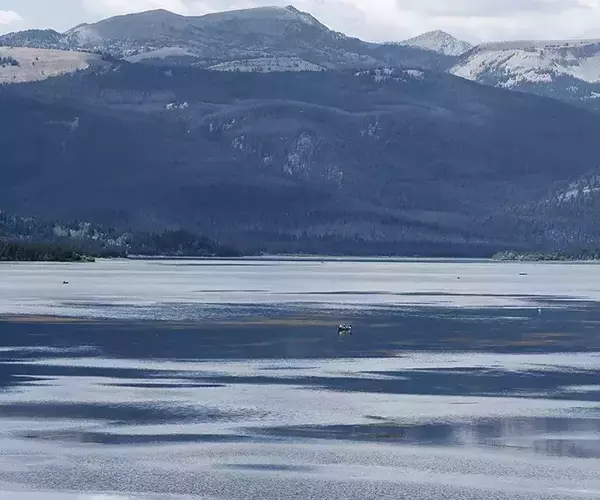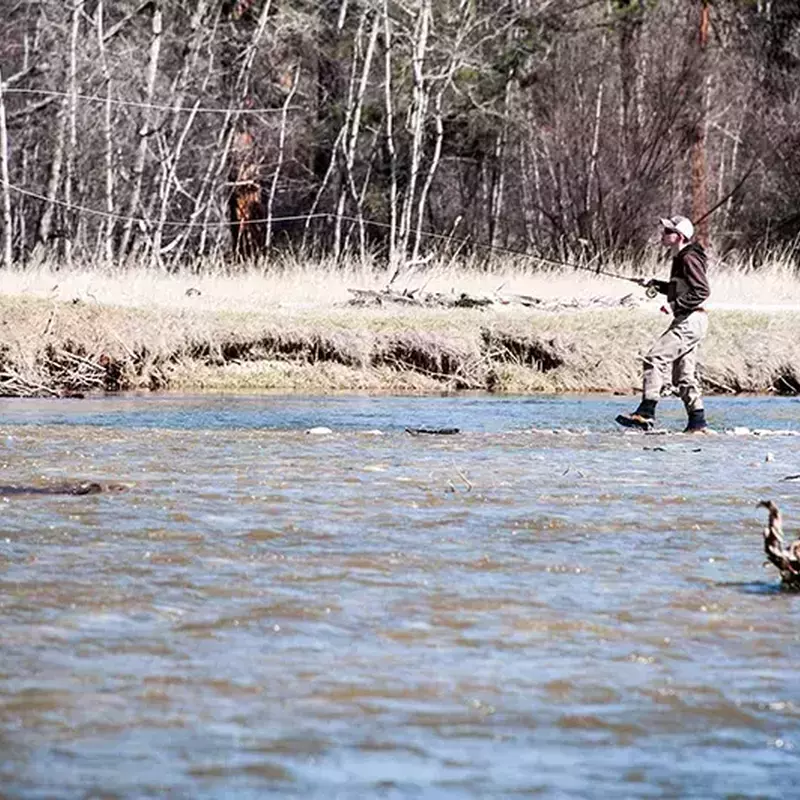Montana Fly Fishing Lakes Near Bozeman in Fall
Posted by: Alex
Date: 10/28/2025
Rivers and streams are the focus of most anglers fly fishing in Montana during the fall months. However, regional lakes and reservoirs continue to offer uncrowded angling opportunities until the first hard freeze of the year.
How Fall Changes Montana Lakes
The lakes connected to our Montana rivers change dramatically in the fall as the weather cools. Ennis Lake, for example, begins to lower as water is released downstream into the Lower Madison River, which pushes fish into the shallower water near Valley Garden. Browns move in to spawn, and rainbows follow right behind them to feed on their eggs.
The water temperature across most Montana lakes stabilizes as nights get longer and colder. That cooling effect pulls trout out of the deep water they sit in during summer and into areas where they can feed more easily. In the fall, fish don’t have to hide from the heat or feed only in short morning or evening windows—they stay active through much of the day. That’s part of what makes lake fishing so good this time of year.

Quake Lake is smaller and steeper than Hebgen Lake, formed when a massive earthquake in 1959 caused a landslide that dammed the Madison River. The lake stretches about six miles, with deep water near the slide area and shallower flats toward the inlet. In the fall, both the inlet and outlet areas becomes a prime spot for targeting trout that are making in the move between the lake and river.
The mix of submerged trees, steep banks, and deep channels gives Quake a lot of structure to fish. It’s one of the most scenic and interesting stillwaters near Bozeman. Legendary for trophy brown trout, fall is a magical time to prospect along edges and dropoffs with streamers.

Hebgen Lake is one of the largest and most well-known stillwaters in Southwest Montana, located just outside of West Yellowstone. Stretching nearly 15 miles long, Hebgen has two main arms—the Madison Arm and the Grayling Arm—both offering plenty of room to explore. The main lake edges all fish well too, especially around the inlet of the South Fork of the Madison River and the bank edges near the dam.
In the fall, the lake drops as water is released downstream, and trout move into the shallows near river and creek inlets. The cooler weather and clear water make it one of the best times to fish it. Whether you’re wading the flats, fishing from a boat, or working along the edges near the Madison Arm, Hebgen offers consistent fall lake fishing in Montana.

Harrison Lake is smaller and shallower than Hebgen or Quake, but that makes it warm up and cool down faster, which is perfect for fall fishing. As the temperatures drop, rainbows and browns move out of the deeper sections, and you can find more fish cruising the banks. Savvy anglers fishing here turn to light colored streamers fished deep along drop-offs and points with significant depth changes.
The lake level drops significantly and fishes well from shore, making it a great option for a few hours of fly fishing near Bozeman. It’s a great option for anglers looking for a smaller lake without a long drive from Bozeman, but always check the weather first as the wind can be relentless this time of year

Ennis Lake sits just north of Ennis, Montana and is one of the easiest lakes to reach from Bozeman. It’s shallow and wide, formed by a dam on the Madison River before it drops into Bear Trap Canyon. In the fall, the cooler weather pulls fish up out of the deeper sections, and you’ll find plenty of browns and rainbows cruising the edges near the inlet of the river.
Most days, fishing from shore is enough—especially when you focus on the drop-offs and weed lines along the north end of the lake. Anglers can spot fish moving along the banks, and target them with leeches and small streamers. Access the Madison River inlet using a boat and concentrate on channel edges for consistent action.
Productive Spots and Tactics
Inlets and outlets are reliable because that’s where fresh oxygen and food flow in. Brown trout, in particular, move to these areas of the lakes in the fall as they begin their upriver migrations during the spawning season.
On Hebgen, the north and south arms can both fish well depending on the wind, while at Quake, the stretch near the outlet and around the cliffs produces the most consistent action.
Streamer fly fishing is usually our guides' preferred approach in the fall. Patterns that imitate small baitfish or leeches—like a small sculpin or woolly bugger—can move fish all day when worked slow and steady.
One key to lake fishing in the fall is slowing down. Trout aren’t chasing fast retrieves like they might in summer, but they’re still active enough to chase down a well-presented fly. Try a slow strip or hand-twist retrieve to keep the fly in front of fish longer when they seem to "turn off" a stripped retrieve.




